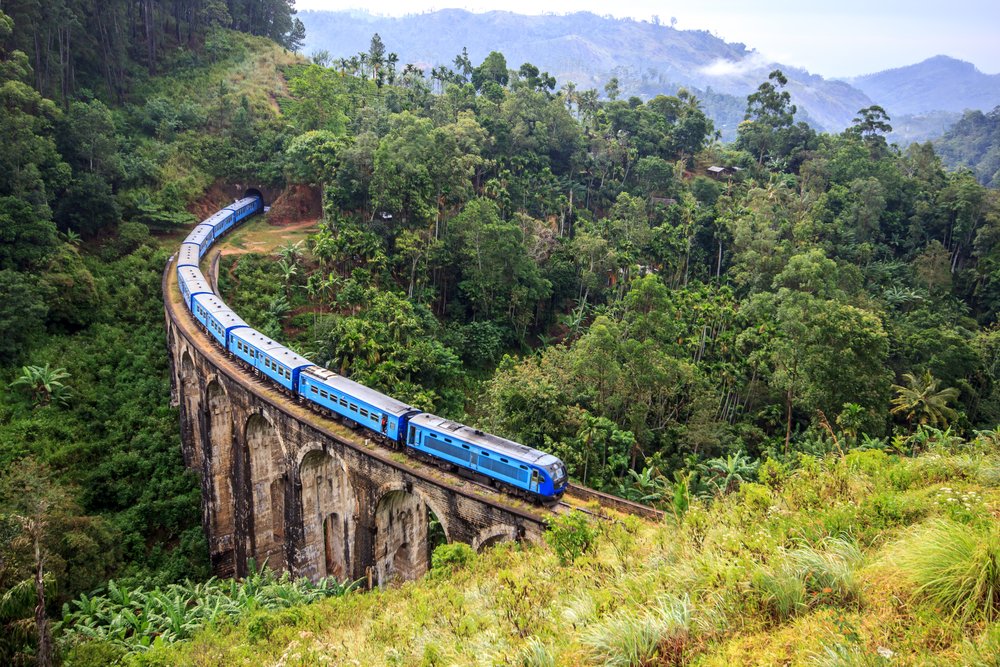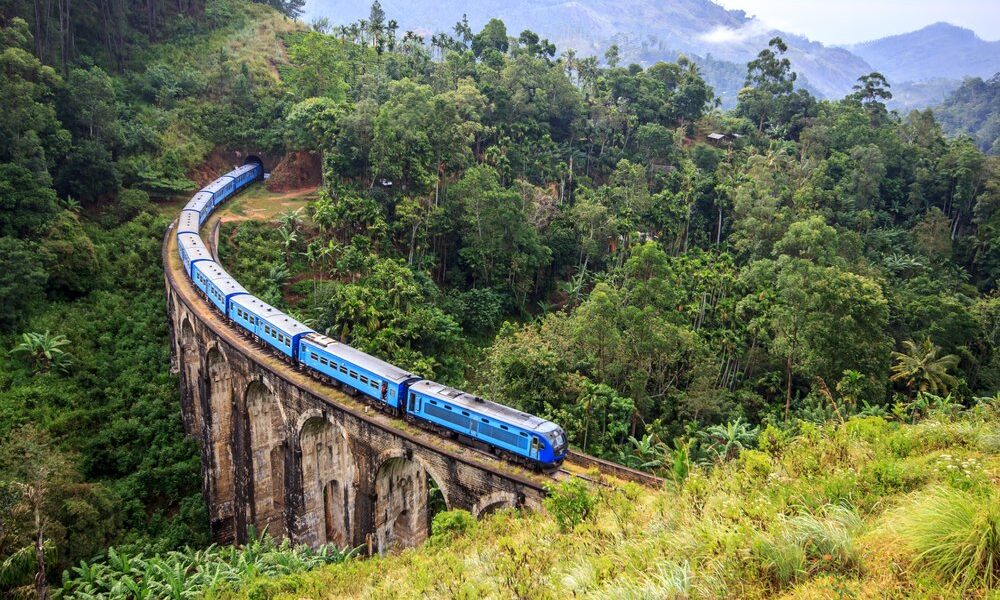
Sri Lanka is a compact country so domestic flights are limited. Newer highways are reducing travel times for those who take the bus. However, trains are the more comfortable way to get around. The best way to see Sri Lanks is on a bike and there is an excellent network of roads to get you around to every corner of the country.
## Flights & Airports
The primary international gateway to Sri Lanka is Bandaranaike International Airport (CMB), conveniently situated approximately 22 miles (35 km) to the north of Colombo. Its proximity to the charming coastal town of Negombo makes it a strategic point of arrival and departure. The journey from Bandaranaike International Airport (CMB) into the heart of Colombo can vary significantly, typically ranging from 45 to 90 minutes, a duration largely influenced by the prevailing traffic conditions.
For travelers facing late departures or arrivals, or those seeking a more relaxed start or end to their Sri Lankan adventure, considering an overnight stay in Negombo can be a wise decision. This eliminates a potentially lengthy transfer to or from the airport, allowing for a smoother transition. Furthermore, if your itinerary includes a cycling tour that commences in the Sigiriya region, Negombo presents an even more advantageous starting location. From Negombo, you can conveniently venture inland towards Sigiriya, and subsequently explore Colombo as you journey back from the south, optimizing your travel route and minimizing unnecessary backtracking.
Colombo itself is a dynamic and rapidly evolving metropolis, offering a diverse array of attractions and activities that can easily fill a couple of days. From historical landmarks and cultural sites to bustling markets and modern shopping districts, Colombo presents a captivating blend of old and new, making it a worthwhile destination to explore.
## Train Travel
The railway network in Sri Lanka, a legacy of the British colonial era, stands as a testament to engineering prowess and remains a reliable and comfortable mode of transportation. In a country where road travel on main thoroughfares can often be slow and less than pleasant due to traffic congestion and winding routes, the train offers a refreshing alternative. It provides a fantastic opportunity to immerse yourself in the scenic beauty of Sri Lanka, bypass some of the more challenging or less captivating segments for cycling enthusiasts, and simply unwind and enjoy the ride.
Among the various railway lines that crisscross the island, three key routes stand out as particularly scenic and highly enjoyable, offering breathtaking views and unforgettable experiences. These routes are:
* Colombo to Kandy: This journey gradually unveils the beauty of the Sri Lankan landscape, with the latter half of the trip offering particularly stunning vistas.
* Kandy to Nanu Oya (Nuwara Eliya): As the train ascends into the highlands, the scenery transforms dramatically, with the second half of the trip showcasing the region’s verdant tea plantations and mist-shrouded mountains.
* Nanu Oya through to Ella: This leg of the journey is arguably the most picturesque, winding through lush green valleys, cascading waterfalls, and breathtaking mountain passes.
The train journey from Kandy to Nanu Oya is particularly renowned for its unparalleled beauty. The route meanders through rolling green hills adorned with meticulously cultivated tea estates, past towering cliffs that plunge into deep valleys, and, during the wetter months, alongside magnificent waterfalls that cascade down steep escarpments. A train ride is highly recommended as an integral part of any trip to Sri Lanka, offering not only a comfortable and efficient mode of transport but also the unique opportunity to freely walk around the train car, interact with fellow passengers, and fully appreciate the spectacular mountain scenery.
### Train classes
Sri Lanka Railways offers a variety of train classes to cater to diverse needs and preferences:
* Government operated first class: Offering a more comfortable and private travel experience.
* Private operated first class: A comfortable alternative but can get crowded.
* Second class: A popular choice among locals and budget-conscious travelers, offering a more authentic experience.
* Third class: The most economical option, often crowded but providing a truly immersive cultural experience.
Advance booking with seat allocation can sometimes be problematic, with tickets frequently selling out quickly. This is often attributed to the practice of ticket scalping. While private first-class tickets also tend to sell out fast, these carriages may not always offer the most pleasant travel experience. In fact, second and third class can often provide a much more interesting and rewarding experience. In these classes, you’ll find yourself surrounded by Sri Lankan people, many of whom will likely be eager to engage in conversation about cricket or inquire about your home country. Consider securing a seat in a more comfortable section of the train, and then venturing into the other carriages to mingle with the locals, share stories, and soak in the breathtaking mountain scenery.
## Road Travel
### Cars
While renting a car and embarking on a self-drive adventure in Sri Lanka is indeed possible, it is essential to acknowledge that driving conditions can be challenging and potentially stressful. If you are not entirely comfortable navigating unfamiliar roads, dense traffic, and unique local driving customs, enlisting the services of a driver is highly recommended. Sri Lanka boasts a well-established system of professional drivers known as “Chauffeur Guides.” These drivers possess not only excellent English language skills but also a wealth of knowledge about the country’s history, culture, and attractions.
Chauffeur Guides typically prefer accommodations in larger hotels, as these establishments often provide dedicated Drivers Quarters, ensuring that the driver is properly fed and accommodated during your stay.
It is important to bear in mind that extended road travel in Sri Lanka can be somewhat tedious due to the prevalence of winding roads and the density of traffic, especially in urban areas. Therefore, selecting a good driver is paramount to ensuring a comfortable and enjoyable journey. Before embarking on your road trip, take the time to meet with the driver, engage in conversation, and assess whether their personality and driving style align with your preferences.
### Buses
The majority of local buses in Sri Lanka are affectionately known as Ashoka Leyland buses. These buses are characterized by a design reminiscent of the 1960s, although some have been retrofitted with air conditioning units for added comfort. While extended travel on one of these buses may not be the epitome of luxury, they provide access to virtually every corner of the country, making them an invaluable mode of local transport for those seeking to explore beyond the main tourist routes.
### Bikes
Cycling presents a remarkable opportunity to experience the diverse landscapes and hidden gems of Sri Lanka. The country boasts an extensive network of roads that wind through verdant tea plantations, along scenic coastlines, and past ancient historical sites. However, venturing out on a cycling tour without some prior knowledge of local road conditions and traffic patterns is not advisable. With adequate preparation and caution, cycling can lead you to some truly amazing places, far removed from the well-trodden tourist paths, offering a unique and unforgettable perspective on the beauty of Sri Lanka.
Motorbikes also warrant a brief mention. While renting and riding a motorbike is an option, it is imperative to possess a valid license. Without the proper documentation, you may find yourself spending a considerable amount of time and money paying “informal fines” to police officers along the way.
B-2525

